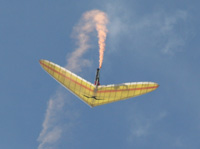EARN YOUR RADIO LICENSE IN ONE DAY!
Sunday, April 17, 2011
8:45AM SHARP! - 3:00PM
Jewish Community Center of San Francisco 3200 California Street at Presidio Avenue There will be a General cram for Techs same place & time, LAST ONE.
See hamcrams.com for parking info. Lunch available in lobby.
Bring 2 IDs (one with picture), a couple of blue ink pens and $20 cash for Technician study materials, tips, and test OR $40 cash for General study materials, lecture, and test OR
$14 cash for testing only (Extra exams available too)
8:45AM SHARP Check-in for study. RSVP pls. Drop-ins OK.
If you want test only (no preparation onsite) come at 2PM.
8:50 Beginners' tips 9:00 Self-study starts, General cram lecture
2:00 Exams begin 3:00 Last tests start
No advance preparation needed for beginners, we do it all in 6
hours. General exam class begins 9:00AM (if you are already
licensed or have already thoroughly mastered the Technician exam material).
Questions? hamcrams.com Next test date July 10, 2011
Passing this test will get you a ham radio license from the FCC good for 10 years. You will be able to use:
O local repeaters for Bay Area communication
O Echolink for Internet-based radio
O satellite and moon-bounce
O international shortwave frequencies for global communication!
Come and join the great world-wide community of ham radio.
Current sponsors/supporters: W5YI VEC
Auxiliary Emergency Radio Organization (AERO) Salvation Army PLEASE POST
How our cramming system works: John Portune, W6NBC, discovered and
Ross Peterson developed and perfected a technique based on the fact that short term memory was a fantastic aid for retaining answers to test questions for an hour or two. From this Ross devised the famous "ham cram" (rapid scanning of questions and answers for just a few hours, then sitting down and taking the test). His method has consistently achieved pass rates of 75-95% and higher.
This method does NOT teach you how to be a radio operator, or even the material which underlies the test questions. This method focuses on your PASSING the test. This is Step 1 in becoming a ham radio operator.
Step 2 is to learn how to use a radio. We sell an inexpensive book to help with Step 2 right after the exam. Step 3 is to buy a radio, and Step 4 is to get on the air, and get experience checking into nets that are used for preparedness and drill. As you progress in Step 4, you may wish to serve as net control for a net some evening.
But first things first--get your license. And that is what this day's activities are all about. Because the test focuses on SHORT TERM memory, there is little purpose in getting the technician test materials in advance.
Study tips: If you want to do some advance preparation, get hold of a high-school physics book and read the part about the relationship between wavelength and frequency and the relationship between current, voltage, resistance and power.
Or: Wavelength x Frequency = Velocity
For radio waves, we use the velocity of light, 300 million meters per second. If we measure frequency in Megahertz (1 million cycles per second), then the formula becomes meters x megahertz= 300. So if I ask you what is the wave-length of a 150 Megahertz signal, the answer is 2m. If you need to convert meters to feet, multiply by 3 and add 10%. A half-wave antenna has one-half wavelength elements. A conventional dipole has two 1/4 wavelength elements.
Current (rate of flow) = amperes (amps) = I
Voltage (pressure) = volts = EMF = E (for electromotive force)
Resistance = ohms = R I=E/R
Power = watts P P=I x E
HAM RADIO LICENSE IN ONE DAY!
1 post
• Page 1 of 1
HAM RADIO LICENSE IN ONE DAY!
USHPA # 30605
H-5, Mentor and Observer
H-5, Mentor and Observer
-

Steve Rodrigues - Site Admin
- Posts: 723
- Joined: Mon May 24, 2004 10:57 pm
- Location: Brisbane, California
1 post
• Page 1 of 1
Who is online
Users browsing this forum: No registered users and 8 guests
